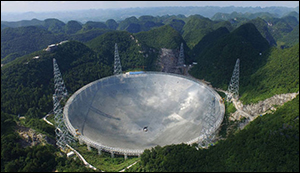China Unveils World's Largest Single-Dish Radio Telescope
27. 9. 2016 | IEEE Spectrum | spectrum.ieee.org
The telescope, which had its official launch last week, has already received astrophysical signals, China’s press agency, Xinhua, reports. The almost 1.2-billion-yuan ($180 million) project was spearheaded by the Chinese Academy of Sciences.
Like the 305-meter-wide dish of the Arecibo Observatory in Puerto Rico, FAST consists of a spherical reflector dish that collects radio signals and focuses them onto the receiver system suspended above it. But FAST, which was built in a natural hollow in southern Guizhou province, also boasts an active reflector surface: triangular panels that make up its dish can be moved to form a smaller, transient reflector, in order to focus and target different locations on the sky.

According to the FAST site, the telescope will have double the raw sensitivity of the Arecibo Observatory. Among other things, it is expected to be able to hunt for the universe’s first stars, search for signals from an extraterrestrial intelligence, and enable the detection of new pulsars—the spinning remnants of dead stars—in our galaxy and others.
Read more at IEEE Spectrum
Image Credit: Chinese Academy of Sciences
-jk-




